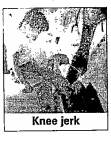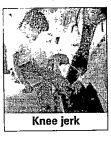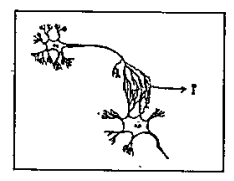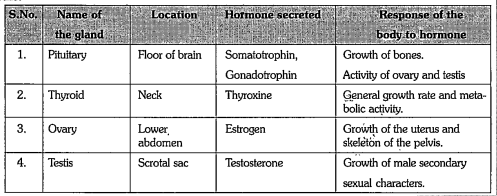Complete Solutions to EXERCISE of chapter COORDINATION of Class 10 book with complete answers and questions
| Class 10 | BIOLOGY |
| Chapter | COORDINATION |
| VGS PUBLICATION-BRILLIANT | EXERCISE |
| Number Of Questions | 100 |
| Academic Year | 2023-24 |
What other functions do you think needed in coordination and balance?
View SolutionWhat triggers movement of the muscles?
View SolutionHow do we respond so fast according to situation ?
View SolutionFill in the missing sections in the following flow chart.

View SolutionDo you think body's team work maintains functioning of our body ? Justify your answer with an example.
View SolutionGiven an example of coordination in your body where both hormonal and nervous controls function together.
View SolutionHow do nervous system and together to coordinate functions of your body ?
View SolutionConsider that you are passing by a garbage disposal area and you immediately cover your nose. Arrange the events belown in a logical order by marking them from (i) to (v) to trace the events that happen in the nervous system from detection of foul smell (stimulus generation) to covering your nose (response).
(i) At the end of the axon, electrical impulse releases chemicals.
(ii) Stimulus received by the dendritic cells of a neuron sets off chemical reaction that creates an electrical impulse.
(iii) Electrical impulse transmitted through cell body and axon.
(iv) The chemicals cross the synapse and reach the next neuron. Similarly, the electrical impulse crosses several neurons.
(v) Finally, the impulse is delivered from neuron to the gland that helps in recognition of the foul smell and muscle cells that help in covering the nose.
View SolutionWhat is a synapse ? How is it useful in transfer of information ?
View SolutionDistinguish between
Stimulus and Response
View SolutionDistinguish between
Afferent and Efferent nerves
View SolutionDistingusih between
Central nervous system and peripheral nervous system
View SolutionDistinguish between
Receptor and effector
View SolutionHow does Phototropism occur in plants?
View SolutionGive an example and explain how plants may immediately respond to a stimulus.
View SolutionHow does mimosa pudica respond when you touch it?
View SolutionSuggest an experiment to show how roots grow away from light in most plants.
View SolutionI am a human hormone. I am secreted from a gland near to neck. I influence general growth rate and metabolic activity in our body. Who am I ?
View SolutionHow does a neuron differ from an ordinary cell in structure ? Write notes.
View SolutionHow does an onion peel cell/cheek cell differ from a neuron in its structure ?
View SolutionIs the structure of neuron suitable for transmission of impulses ? Analyse.
View SolutionMan is the most intelligent animal. What could be the fact that helped us to reach such a conclusion?
View SolutionThe axon of nerve cell in hand is shorter than the axon of nerve cell in leg. Do you support this statement ? Why?
View SolutionOrgans respond to the external stimulus by a fraction of second. How do you feel about such controlling mechanism of human body ?
View SolutionState whether the following actions are voluntary action, reflex action or conditioned reflex.
i) Blinking ii) Cleaning the table iii) Playing on the keyboard iv) Salivating when food is put in the mouth v) We close our ears when we hear unbearable sound.
View SolutionState whether the following actions are voluntary action, reflex action or conditioned reflex.
i) Blinking ii) Cleaning the table iii) Playing on the keyboard iv) Salivating when food is put in the mouth v) We close our ears when we hear unbearable sound.
View SolutionState whether the following actions are voluntary action, reflex action or conditioned reflex.
i) Blinking ii) Cleaning the table iii) Playing on the keyboard iv) Salivating when food is put in the mouth v) We close our ears when we hear unbearable sound.
View SolutionState whether the following actions are voluntary action, reflex action or conditioned reflex.
i) Blinking ii) Cleaning the table iii) Playing on the keyboard iv) Salivating when food is put in the mouth v) We close our ears when we hear unbearable sound.
View SolutionState whether the following actions are voluntary action, reflex action or conditioned reflex.
i) Blinking ii) Cleaning the table iii) Playing on the keyboard iv) Salivating when food is put in the mouth v) We close our ears when we hear unbearable sound.
View SolutionWhat will happen to the potted plant kept near window in the room ?
View SolutionWhat happens if all functions of the human body are controlled only by brain ?
View SolutionIf you visit a doctor, what doubts you would like to clarify about pancreas ?
View SolutionCollect information on the actions controlled by spinal cord by using reference books from your school library.
View SolutionDraw neatly labelled diagram of Brain and write few points how it is protected.
View SolutionYou are walking in the traffic. Suddenly you heard a loud sound. How does coordination take place in this situation among respected organs ? Draw a block diagram to explain this situation.
View SolutionMake a model of neuron using suitable materials.
View SolutionObserve different actions performed by your classmate for a period of 45 minutes. Out of these actions which are contolled by voluntary and involuntary pathways?
View SolutionIts very interesting to watch a creeper entwining its tendril to the support. Is not it ? How do you express your feelings in this situation ?
View SolutionHormones are released at a specific place, specific time for a specific function. Prepare a cartoon on hormones with a nice caption.
View SolutionThe largest region of the brain is ……………………
View SolutionA point of contact between two neurons is …………
View Solution…………… phytohormone is responsible for cell elongation and differentiation of shoots and roots.
View SolutionThyroxine is responsible for …………
View SolutionGibberellins and auxins promote growth in plants while absciscic acid arrests the same. Some situations are discussed here. State which hormones would be needed any why ?
a) A gardener wants large dehlias, he should use along with nutrients and other things ............... hormone.
View SolutionGibberellins and auxins promote growth in plants while absciscic acid arrests the same. Some situations are discussed here. State which hormones would be needed any why ?
a) A gardener wants large dehlias, he should use along with nutrients and other things ............... hormone.
View Solutionc) Seeds are to be stored a long time ………….. Hormone can help.
View SolutionGibberellins and auxins promote growth in plants while absciscic acid arrests the same. Some situations are discussed here. State which hormones would be needed any why ?
a) A gardener wants large dehlias, he should use along with nutrients and other things ............... hormone.
View SolutionA person has loss of control on emotions, which part of brain stops its function ?
View SolutionLeaf movement in mimosa helps to
View SolutionDiabetes is related to this gland.
View SolutionWhat is knee jerk reflex?

View SolutionWhat changes do you observe in the thigh muscle ?
View SolutionWhat do we call this type of response?

View SolutionWhat do we call the action of kicking a foot ball ?
View SolutionHow is the knee jerk action takes place ?
View SolutionDo you think most of the functions in our body go about in an involuntary manner? Why? Why not?
View SolutionGive some examples of situations in plants responding to a certain stimulus.
View SolutionTake a glass jar and fill with soil. Show a bean seed near the wall of the jar. After 4 - 5 days you will notice seed germination. Keep the jar under the sun. Observe how root and shoot grows. Then tilt the glass jar and keep the plant horizontally. Observe the direction of the root and shoot growth for more than a week
iv) Who performed experiments on phototropism?
View SolutionWhat did charles Darwin and his son Francls Darwin State on their experiment ?
View SolutionHow did Went came to know about auxin?
View SolutionWhat is the meaning of auxin in Greek?
View SolutionWhat helps us to respond to such signals ?
View SolutionWhy does the living body respond to such signals ?
View SolutionWhat did Galen conclude after his observations?
View SolutionWhat do you think that the information carried on the afferent and efferent nerves ?
View SolutionWhich root according to you get signals from afferent nerves ?
View SolutionTo which organs of the body do the nerves go from the ganglions near the vertebral column ?
View SolutionWhat are the organs that receives nerves starting from the brain?
View SolutionWhich are the organs whose activities are influenced by the sympathetic nervous system?
View SolutionWhich are the organs whose activities are influenced by the parasympathetic system ?
View SolutionWhy do you think Galen drew such a conclusion ?
View SolutionWhat other effectors would act under these circumstances?
View SolutionWhat are association nerves?
View SolutionAccording to you what would be the function of the spinal cord ?
View SolutionAre all functions of our body under direct control of the brain and spinal cord ? What do you think So?
View SolutionWhat do you think the end of these nerves act at the muscular end?
View SolutionWhat do you understand about the functions of parasympathetic system ?
View SolutionWhat do you understand about the functions of sympathetic system ?
View SolutionThink of any action and try to make a sketch of reflex arc ?
View SolutionA plant which grows near a window bends towards sunlight write the reason for it.
View SolutionWrite the names of the nerve given in the following diagram and write its function.

View SolutionIdentify the given part in the diagram and write its use.

View SolutionWhich part of the brain helps to maintain posture and equilibrium ?
View SolutionWhat is the significance of the adreanal gland in the human body ?
View SolutionWrite the difference between hormone and enzyme.
View SolutionWhat questions you will ask a palaeontologist about fossils?
View SolutionWhich part of the brain is involved in loss of control when a person drinks alcohol
View SolutionThe brain is responsible for
View SolutionHow do we get fits?
View SolutionHow do we get paralysis?
View SolutionWhat kind of food should we take to increase I.Q.?
View SolutionExplain two tropic movements with suitable examples.
View SolutionPrepare a table showing tropic movements in plants in response to stimuli.
View SolutionGive two examples of voluntary actions.
View SolutionWrite the difference between hormone and enzyme.
View SolutionWhat are the divisions of brain ?
View SolutionExplain the different parts of the brain and their functions in a tabular form.
View SolutionWrite in a tabular form the different parts of human brain and their functions.
View SolutionRead the following table and answer the questions given below.

1. Write the importance of glands and hormones.
View SolutionWhich hormone is responsible for growth of bone ?
View Solution
EXERCISE questions and complete solutions for chapter COORDINATION of VGS BRILLIANT BIOLOGY (TELUGU ENGLISH) of Class 10